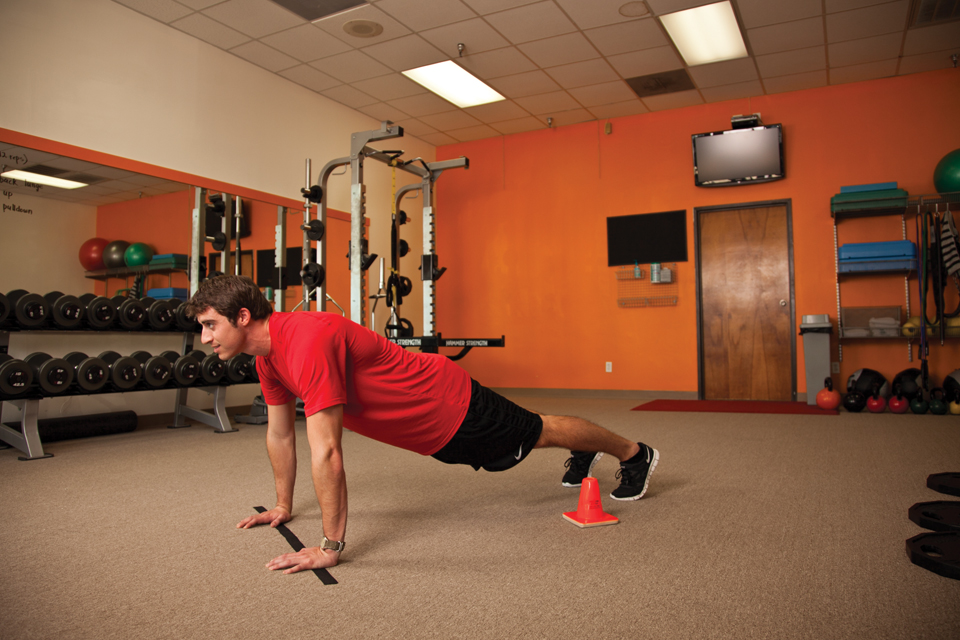10 Tests to Help Find Austin’s Fittest Athletes

In the search for Austin’s fittest athletes, we have chosen ten tests that measure various aspects of speed, endurance, strength, and power. These tests are safe, appropriate, and duplicable for several age groups. To register, go towww.aftmfittest.com
1. Standing Medicine Ball Throw (Upper Body Power)
Stand with feet planted behind designated start line. Hold an eight-pound medicine ball with both hands at chest level, and perform a chest pass for maximum distance. You may use your hips, back, and knees, but feet must remain planted at all times, and the ball must be released with both hands together. Distance from the start line to where the ball has made contact with the ground is recorded. Best of two attempts is scored.
2. Standing Broad Jump (Lower Body Power)
Start in a standing position with toes just behind the start line, then jump out as far as possible. Distance is measured from the heel closest to the start line or the closest body part if the athlete falls to the ground. Best of two attempts is recorded.
3. 40-Yard Dash (Sprint Speed)
Athletes start in a static position behind start line in whatever position they choose, though three-point stance is recommended. As soon as a motion is made, time starts and is stopped as any part of the athlete crosses the finish line. Best of two attempts is recorded in seconds and to two decimal points.
4. Agility Run Arrow Head Left/Right (Agility and Athleticism)
Start in static stance behind cone on opposite side of the direction of the first cut (left of cone if doing the right side agility test). Clock starts on first movement, and athlete cuts on topside of the first cone, weaves under and around outside cone, over top of farthest cone, then sprints back to start. Average the right and left times for the final score, which is recorded in seconds and to two decimal points.
5. Precision Throw (Accuracy, Coordination, and Skill)
Athletes start and must remain behind line at all times. Using whatever throwing technique, athlete gets five throws to get the softball through the center of the designated tire. Best out of five scored.
6. Pull-Ups/Chin-Ups (Upper Body Strength)
Start in hanging position with arms fully extended and body in a vertical line. Athlete pulls body upward until chin crosses the bar without kipping, swinging, or kicking the legs, and returns to fully extended position for each good repetition. Repetitions are counted until athlete releases hands from bar.
7. Burpees (Total Body Strength Endurance and Overall Work Capacity)
Start in push-up position and place hands on the start line. Distance is measured to the bottom of the kneecap where a cone is placed to mark “extended position.” Athlete then stands up and starts in a static position. When judge signals start, the athlete squats, places hands on the start line, kicks legs (together) back in one motion, then pulls legs back in together in one motion, and stands fully upright reaching hands over head, arms fully extended. Each kick back of legs must cross the back cone measured from the start to count as a good rep. Judge counts total reps achieved in one minute.
8. Hand Grip of Dominant Hand (Hand and Forearm Strength)
Hold hand dynamometer in dominant hand and extend arm straight out from shoulder. Athlete squeezes dynamometer with consistent maximal effort (no jerking or pulsing allowed). Score is listed in pounds with no decimal points. Highest number of two attempts is recorded.
9. Interval Test (Tests Speed Endurance and Conditioning)
Start at designated start line. Cones are marked at 16, 18, 20, 22, 24, 26, 28, 30, 32, and 34 yards from start line. Begin run on the sound of the whistle. Run to the first level distance, touch line with foot, then return by crossing the start line with some part of body. Each interval must be completed in ten seconds and has a designated ten-second recovery to return to start position. Athlete repeats the three runs at each interval level until they cannot finish in the designated time. The athlete is then scored by the level reached (1-10).
10. 1 Mile Run (Long Distance Speed and Aerobic Endurance)
Start from behind start line. Athlete must stay on marked path of the designated running area and complete the one-mile distance. Time is recorded as any part of the body crosses the finish line. Time is recorded to two decimal points.






